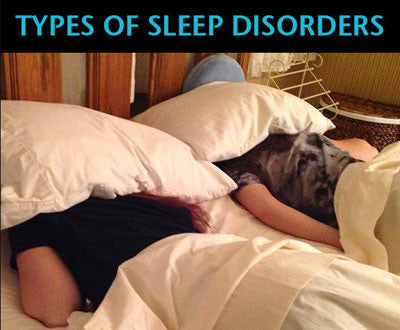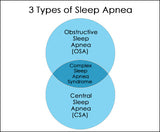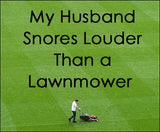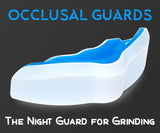Who Knew There Were So Many Types of Sleep Disorders?
Sleep is considered one of the three pillars of good health, along with exercise and eating healthy foods, and they can all have a profound impact on each other. Regular exercise and a healthy diet usually increase the chances of a good night's sleep, unless a sleep disorder throws things out of balance.

Most people are familiar with insomnia and snoring, but the most recent version of the International Classification of Sleep Disorders (ICSD-3) released in 2014, lists 60 specific sleep disorders in six major categories.
6 Categories of Sleep Disorders
The ICSD-2 released in 2005 organized sleep disorders into 3 broad categories, while version 3 extended the number of categories to six, which include the following:
- Insomnia
- Sleep Related Breathing Disorders
- Central Disorders of Hypersomnolence
- Circadian Rhythm Sleep-wake Disorders
- Parasomnias
- Sleep Related Movement Disorders
All told, there are between 60 and 80 different sleep disorders that fall under the above categories.
What are Common Sleep Disorders?
Insomnia
One of the most widely known sleep disorders, people with insomnia have problems falling asleep, staying asleep, or wake earlier in the morning than expected. According to the National Sleep Foundation, insomnia can be caused by medical conditions such as chronic pain, depression or anxiety, other sleep disorders, and even from the effects of medications.
A sleep specialist can often determine the cause and recommend a course of treatment that focuses on the root cause. For some people, surgery might be necessary.
Snoring
Snoring is so common that approximately 70 million people snore on a regular basis. It unusually has a greater impact on a spouse or family member than it does on the person doing the snoring, but nonetheless it can be very annoying.
Both men and women of all ages snore when the tongue and throat relax during sleep and air from breathing causes the soft palate to vibrate. Mayo Clinic recommends lifestyle changes to treat some symptoms of snoring, which include sleeping on your side and not your back, avoiding alcohol before bedtime, and losing weight.
Sleep Apnea
Many people confuse sleep apnea with snoring, but they are completely different disorders. The National Institutes of Health describes sleep apnea as a condition that causes a person to pause or stop breathing during sleep for a few seconds to minutes. These pauses can occur up to 30 times an hour.
There are different types of sleep apnea but the most common is Obstructive Sleep Apnea in which the airway is blocked while sleeping. It is a serious problem and can cause many health problems like high blood pressure, stroke, or even a heart attack.
It's imperative to find a treatment that works including weight management, an oral appliance or CPAP (Continuous Positive Airway Pressure) machine.
Bruxism (Teeth Grinding)
The medical term for teeth grinding and clenching is "Bruxism" and it usually occurs at night, although some people grind their teeth during the day as well.
It can cause worn or chipped teeth, TMJ (Temporomandibular Joint Syndrome), neck pain, and headaches, along with a variety of other symptoms. A night grind guard is one of the most popular ways to treat bruxism, but stress and anxiety management are also recommended.
Restless Leg Syndrome (RLS)
RLS, also known as Restless Leg Syndrome or Willis-Ekbom Disease, is classified as both a sleep disorder and a movement disorder. It usually occurs at night during sleep, or it can be triggered when awake and resting or lying down in bed before going to sleep.
It is difficult to describe to somebody that has never experienced it, but most people describe it as an uncomfortable sensation in the legs that feels like itching, crawling, or throbbing. It can occur in men or women at any age, although it is more common in middle age and older. Iron and certain medications can bring relief but the most common temporary treatment is to get out of bed and walk around for a bit.
Narcolepsy
Narcolepsy is a neurological sleep disorder that affects men and women equally (about 1 in 2,000 people) and causes excessive sleepiness during the day and many sufferers uncontrollably fall asleep. This can be extremely dangerous if driving or at other inappropriate times. Sometimes hallucinations or sleep paralysis can accompany the daytime episodes.
The cause of Narcolepsy is generally unknown but it is thought to be related to a chemical in the brain called hypocretin. There is no cure although some of the symptoms can be treated with medication.
Other Sleep Disorders Include:
- Sleep-related Hypoxemia Disorder
- Kleine-Levin Syndrome
- Hypersomnia
- Insufficient Sleep Syndrome
- Delayed Sleep-Wake Phase Disorder
- Shift Work Disorder
- Jet Lag Disorder
- Sleepwalking
- Sleep Terrors
- Sleep-Related Eating Disorders
- REM Sleep Behavior Disorder
- Recurrent Isolated Sleep Paralysis
- Nightmare Disorder
- Exploding Head Syndrome
- Sleep-Related Hallucinations
- Sleep Talking
- Periodic Limb Movement Disorder
- Sleep Related Leg Cramps
- Sleep-Related Movement Disorder Due To Medication Or Substance
While this may seem like a big list of sleep disorders, there are actually many more sub-categories not included here. The full list includes between 60 and 80 different types of sleep related disorders and more may be discovered in the future.
If you or a loved one has trouble sleeping or think you might be experiencing some kind of sleep disorder, it's important to consult a doctor and schedule a sleep study with a reputable sleep clinic. Most disorders can be treated, and improvements in sleep can have a dramatic impact on overall health.






